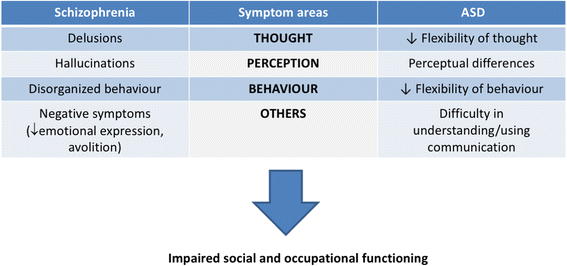Bridging Autism Spectrum Disorders and Schizophrenia through inflammation and biomarkers - pre-clinical and clinical investigations
- PMID: 28870209
- PMCID: PMC5584030
- DOI: 10.1186/s12974-017-0938-y
Bridging Autism Spectrum Disorders and Schizophrenia through inflammation and biomarkers - pre-clinical and clinical investigations
Abstract
In recent years, evidence supporting a link between inflammation and neuropsychiatric disorders has been mounting. Autism spectrum disorders (ASD) and schizophrenia share some clinical similarities which we hypothesize might reflect the same biological basis, namely, in terms of inflammation. However, the diagnosis of ASD and schizophrenia relies solely on clinical symptoms, and to date, there is no clinically useful biomarker to diagnose or monitor the course of such illnesses.The focus of this review is the central role that inflammation plays in ASD and schizophrenia. It spans from pre-clinical animal models to clinical research and excludes in vitro studies. Four major areas are covered: (1) microglia, the inflammatory brain resident myeloid cells, (2) biomarkers, including circulating cytokines, oxidative stress markers, and microRNA players, known to influence cellular processes at brain and immune levels, (3) effect of anti-psychotics on biomarkers and other predictors of response, and (4) impact of gender on response to immune activation, biomarkers, and response to anti-psychotic treatments.
Keywords: Animal model; Anti-psychotics; Autism spectrum disorders; Biomarker; Clinical research; Immune cells; Inflammation; Microglia; Schizophrenia; microRNA.
Conflict of interest statement
Ethics approval and consent to participate
Not applicable.
Consent for publication
Not applicable.
Competing interests
The authors declare that they have no competing interests.
Publisher’s Note
Springer Nature remains neutral with regard to jurisdictional claims in published maps and institutional affiliations.
Figures


References
-
- Liu X, et al. Genetics implicate common mechanisms in autism and schizophrenia: synaptic activity and immunity. J Med Genet. 2017;54(8):511–20. - PubMed
Publication types
MeSH terms
Substances
LinkOut - more resources
Full Text Sources
Other Literature Sources
Medical

